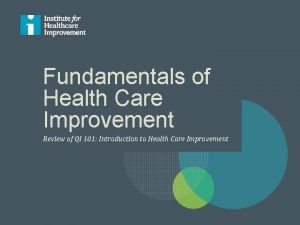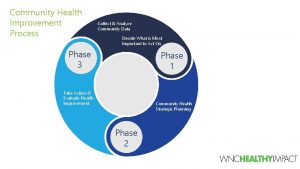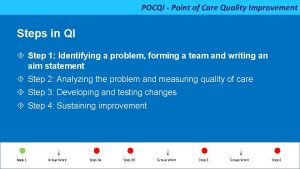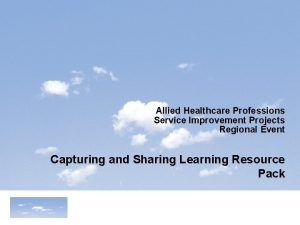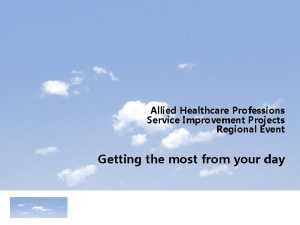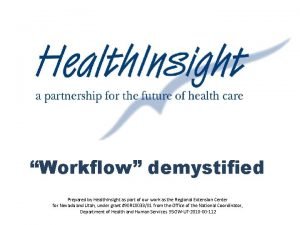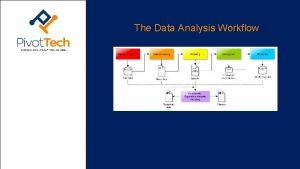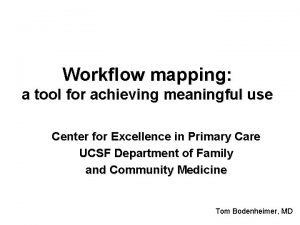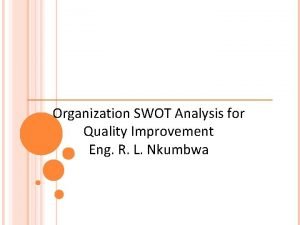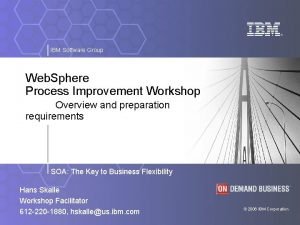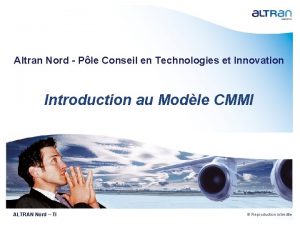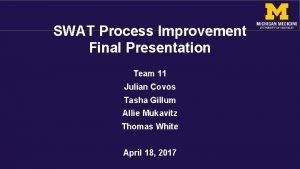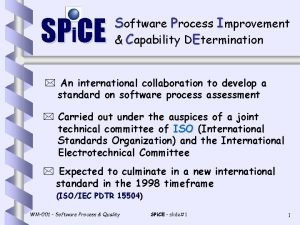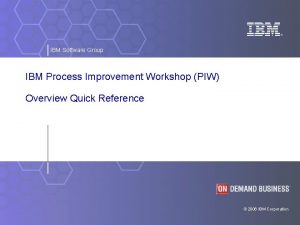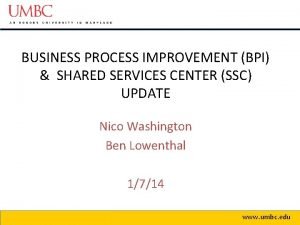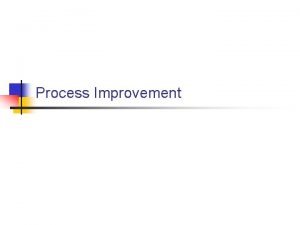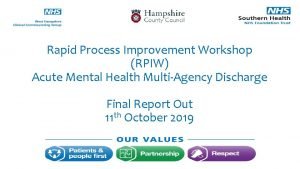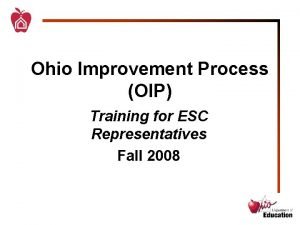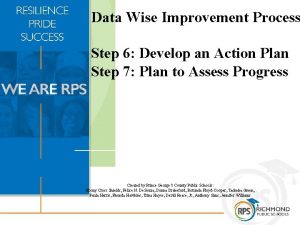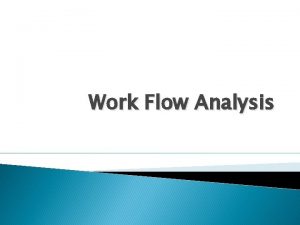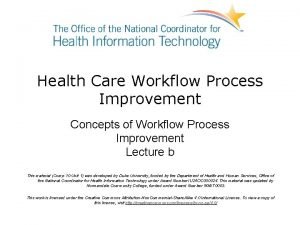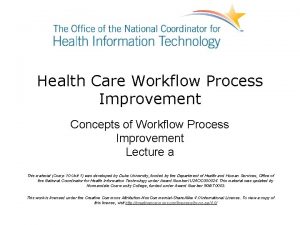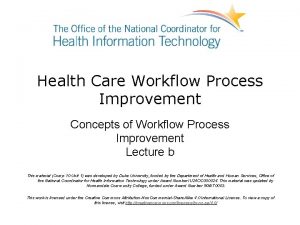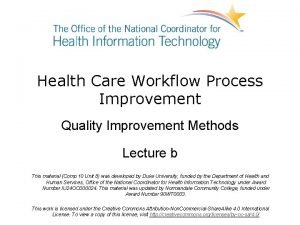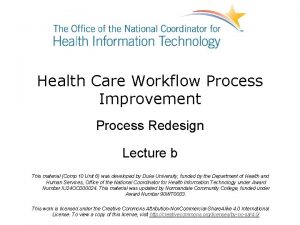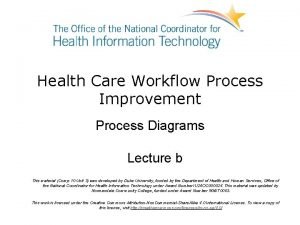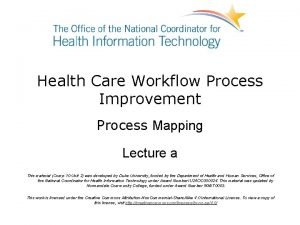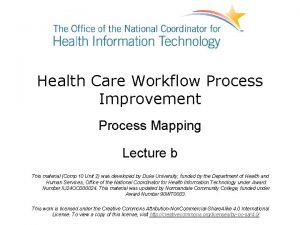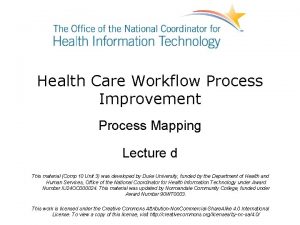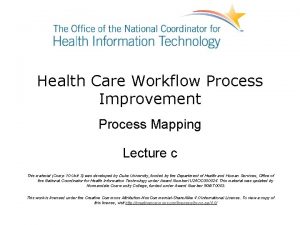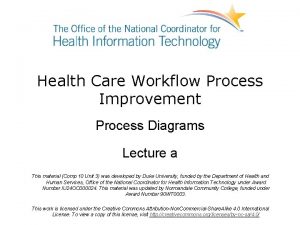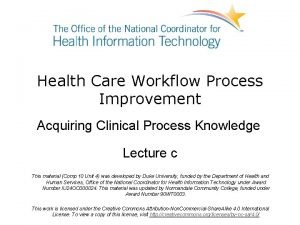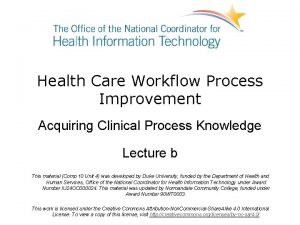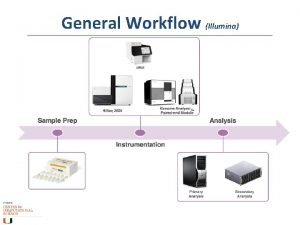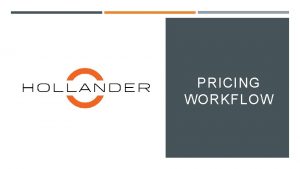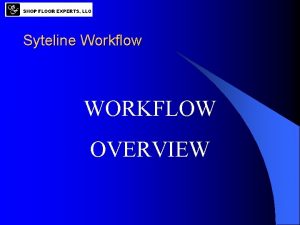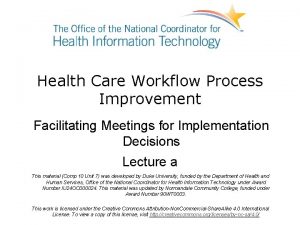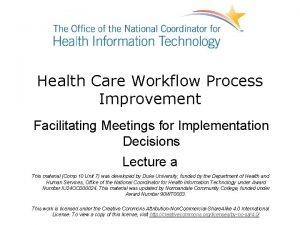Health Care Workflow Process Improvement Process Analysis Lecture





























- Slides: 29

Health Care Workflow Process Improvement Process Analysis Lecture b This material (Comp 10 Unit 5) was developed by Duke University, funded by the Department of Health and Human Services, Office of the National Coordinator for Health Information Technology under Award Number IU 24 OC 000024. This material was updated by Normandale Community College, funded under Award Number 90 WT 0003. This work is licensed under the Creative Commons Attribution-Non. Commercial-Share. Alike 4. 0 International License. To view a copy of this license, visit http: //creativecommons. org/licenses/by-nc-sa/4. 0/

Process Analysis Learning Objectives • Perform a process analysis for a given clinic scenario • Given results of a process analysis, draft a summary report • Given results of a process analysis, identify desired electronic medical record functionality 2

Process Analysis Topics - Lecture b • Process Variations for common clinic processes – Patient check-in – Patient visit – Prescription – Received documentation – Labs & diagnostic tests – Referral and consults – Disease management – Billing • Identifying EHR functionality from Process Analysis 3

Process Variations and Exceptions • Variations: Processes used by the clinic • Exceptions: Errors or common odd things that come up during the process. 4

Common Process Variations & Exceptions: Patient Check-In • Patient check-in variations – New patient – Existing patient – Walk-in • Patient check-in exceptions – No insurance / non-covered service – Change in insurance information 5

Common Process Variations & Exceptions: Patient Visit • Patient visit variations – Referral out needed – Procedure needed – Diagnostic test needed • Patient visit exceptions – Emergent reason to stop visit – Non-covered service needing separate visit – Need to be seen by different provider 6

Common Process Variations & Exceptions: Prescription • Prescription variations – Paper – Electronic – Refill call-in needed – Other call-in needed • Prescription exceptions – No insurance / non-covered service – Samples provided – Prescriptions to multiple pharmacies – Prescription can’t be filled at pharmacy 7

Common Process Variations & Exceptions: Received Documentation • Received documentation variations – Paper – Electronic – Triggers patient contact • Received documentation exceptions – Inadequate patient identification – Inadequate source identification – Unintelligible or ambiguous information 8

Common Process Variations & Exceptions: Labs • Lab variations – Sample taken in clinic, test done in clinic – Sample taken in clinic, test done externally – Sample and test done at central lab • Lab exceptions – Bad sample – need another – Results not received – Lab results not physiologically possible 9

Common Process Variations & Exceptions: Diagnostic Tests • Diagnostic test variations – Test done in clinic – Test done externally – Report expected – Image or test result data expected • Diagnostic test exceptions – No insurance / non-covered service – Test error / unintelligible results – Results from external test not received 10

Common Process Variations & Exceptions: Referral • Referral variations – Paper via patient – Paper provider to provider – Electronic – Multiple referrals • Referral exceptions – Referee does not accept the referral 11

Common Process Variations & Exceptions: Consult • Consult variations – Paper / phone request – Electronic • Consult exceptions – No insurance / non-covered service – Consult no-show 12

Common Process Variations & Exceptions: Disease Management • Disease management variations – Paper – Electronic • Disease management exceptions – Insufficient data – Data errors – Care fragmentation – Contraindications 13

Common Process Variations & Exceptions: Billing • Billing variations – Paper (superbill as source) – Electronic – Where coding is done – Billing & collections done externally • Billing exceptions – No insurance / non-covered service – Claim denied – Coding errors – Data errors 14

Steps for Process Analysis • Start with process Inventory & diagrams – Context diagram showing clinic functions – Flowchart for each process • For each process, list – Variations applicable to the clinic – Exceptions • Report findings – Major observations – EHR functionality necessary to support clinic functions – Opportunities for improvement 15

Process Analysis Example • As a process analyst working with Suburban Family Clinic, you have listed appointment scheduling on the process inventory. Read the “By Phone Appointment Scheduling Scenario” in the course materials. – Draw a role-based flow chart of the process – Indicate the process variations used by Suburban Family Clinic – Make a list of exceptions likely to occur with this process 16

Role-Based Flowchart Suburban Family Clinic By Phone Appointment Scheduling 17

Process Variations & Exceptions • Suburban Family Clinic • By Phone Appointment Scheduling: – Appointment scheduling variations o By phone – Appointment scheduling possible exceptions o Receptionist doesn’t answer, patient leaves message o Someone other than patient calls o Requested provider not available o Available appointment time slots not acceptable 18

Translating Analysis Results to EHR Functionality Source: Nahm, M. , Duke University, 2012. 19

From Process Analysis to EHR Functionality Requirements • Process variations → needed functionality • Common process exceptions → needed functionality 20

Example: Process Analysis Results • Read the following Scenarios: – By-phone appointment scheduling – New patient intake and registration using paper chart – Existing patient intake and registration using paper chart – Receiving and communicating lab results using paper chart • Create a Process and Exception List 21

Example: Phone Scheduling • Process: By phone scheduling • Exceptions: – Receptionist doesn't answer, patient leaves message – Someone other than patient calls – Requested provider not available – Available appointment time slots not acceptable 22

Example: Patient Intake • Processes: – New patient intake – Existing patient intake • Exceptions: – No insurance / non-covered service – Patient has to leave during intake process 23

Example: Lab Scenario • Processes: – Lab sample processing at external lab – Lab sample acquisition – unknown from the scenario – Receiving lab results – Communicating lab results • Exceptions: – No results received – Results not matchable to a patient – Results not matchable to a provider – Results abnormal and require action – Patient not contactable / not responsive to contact attempts 24

After the Process Analysis • The list of processes and exceptions are compiled together in one document and provided to the clinic • This list corresponds to needed EHR functionality – Included in process analysis report – Ultimately included in a request for proposal intended for EHR software vendors • Where process diagrams are created as part of the process analysis, they are included in the report 25

Process Analysis Report Should Include • • • Information about the analysis Process inventory Process variations and exceptions Process diagrams List of EHR functionality needed for the practice 26

Process Analysis Summary – Lecture b • Process Variations for common clinic processes – Patient check-in – Patient visit, Disease management – Prescription – Received documentation – Labs & diagnostic tests – Referral and consults – Billing • Process Analysis and EHR functionality 27

Process Analysis References – Lecture b References There are no references for this lecture. Images Slide 17: Role-Based Flowchart. Nahm, M. (2012) Slide 19: Translating Analysis Results to EHR Functionality. Nahm, M. (2012 ) 28

Process Analysis Lecture b This material was developed by Duke University, funded by the Department of Health and Human Services, Office of the National Coordinator for Health Information Technology under Award Number IU 24 OC 000024. This material was updated by Normandale Community College, funded under Award Number 90 WT 0003. 29
 Qi 101: introduction to health care improvement
Qi 101: introduction to health care improvement Community health improvement process
Community health improvement process Wnchi
Wnchi 01:640:244 lecture notes - lecture 15: plat, idah, farad
01:640:244 lecture notes - lecture 15: plat, idah, farad Primary secondary and tertiary health care
Primary secondary and tertiary health care Unit 2 equality diversity and rights
Unit 2 equality diversity and rights Health and social component 3
Health and social component 3 Pocqi
Pocqi Ohio state health improvement plan
Ohio state health improvement plan The allied health profession service improvement project
The allied health profession service improvement project The allied health profession service improvement project
The allied health profession service improvement project Workflow analysis
Workflow analysis Analysis workflow
Analysis workflow Workflow process mapping for ehr implementation
Workflow process mapping for ehr implementation School improvement plan sample deped
School improvement plan sample deped Swot analysis for quality
Swot analysis for quality Sample swot analysis of a school in the philippines
Sample swot analysis of a school in the philippines Uphcp
Uphcp Health economics lecture notes
Health economics lecture notes Ibm checkpoint goals examples
Ibm checkpoint goals examples Standard cmmi appraisal method for process improvement
Standard cmmi appraisal method for process improvement Swat process improvement
Swat process improvement Software process improvement and capability determination
Software process improvement and capability determination 7 step improvement process itil
7 step improvement process itil Ibm process improvement
Ibm process improvement Shared services process improvement
Shared services process improvement Test process improvement
Test process improvement Rpiw process
Rpiw process Ohio improvement process
Ohio improvement process Data wise action plan template
Data wise action plan template
